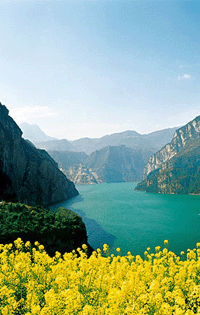|
|
Xiling Gorge
 |
| |
The Xiling Gorge in Hubei province, the last of the Three Gorges on the Yangtze, is 75 kilometers long from the mouth of the Xiang Stream to Nanjing Pass. In the gorges there is a break of 35 kilometers of open valley, so the gorge is actually 40 kilometers long. Therefore ancient people were justified in believing the Wu Gorge to be the longest. As the poem says, "Among the Three Gorges to the east of Ba, the longest is the Wu Gorge". In the past, the Xiling Gorge used to be a dangerous part of the Yangtze for boats because of its numerous dangerous shoals, reefs and whirlpools in the river.
But thanks to efforts made in dredging the waterway after liberation in 1949, specifically since the completion of the Gezhouba Dam Project, this part of the Yangtze has become a safe and beautiful waterway. |
| |
Dam Project, this part of the Yangtze has become a safe and beautiful waterway.
In the Xiling Gorge, west of the open valley stands the Bingshu Baijian Gorge (the Gorge of Military Books and Swords) and the Niugan Mafei Gorge (the Gorge of Ox Livers and Horse Lungs), and east of the open valley are the Huangniu Gorge (the Yellow Ox Gorge) and the Dengying Gorge (the Lamp Shadow Gorge). All these names suggest their appearances. The most famous historical sites, cultural relics, and natural scenery in this area are the Huangling Temple and the Sanyou Cave.
The Huangling Temple is located on the southern bank of the Yangtze, 620 kilometers from the central part of Chongqing. The temple is the largest ancient building in the Xiling Gorges area, first built during the Spring and Autumn period (770-476 B.C), then rebuilt in the Tang Dynasty and repaired in 1618 during the Ming Dynasty. Inside the gate there is an opera building housing a stage, King Yu's Palace, and a Memorial Temple of Zhuge Liang.
Inside the memorial temple was a stone tablet of the temple, but unfortunately the tablet is no longer there. There stands a three-meter tablet on the west side of King Yu's Palace; on the tablet is inscribed "Note on Dredging the River" carved in 1773. After recent repairs, the temple now looks magnificent.
|
|


|
|
| |
| The Sanyou Cave is located on the northern bank of the Yangtze ten kilometers from the urban area of Yichang. The cave was the place where Bai Juyi and two other famous poets of the Tang Dynasty gathered and later they wrote poems about their visit to the cave. Therefore the cave was named Sanyou cave, meaning, "cave visited by three". Later three scholars of the Song Dynasty, Su Xun and his sons Su Shi and Su Zhe, also visited the cave, and their visit was known as the "later visit by three". |
| |
|
|